From the April 2023 issue of Apollo. Preview and subscribe here.
On a cold, sunny day earlier this year, around 3,000 walkers could be found on Dartmoor, waving flags, beating drums and playing instruments. They were on top of the moor to perform a ceremony to raise the mythical guardian of the place. Old Crockern was imagined by the walkers as a great green beast, swaying to the drumming and covered in colourful strips of fabric with a grey, craggy head, rather like the layered rocks that sit on top of nearby Crockern Tor. Old Crockern’s legend has him being called upon to defend the moors from a landowner who sought to farm the land for his own benefit, taking it from the local people. After Old Crockern appeared to one of the locals in a vision promising revenge, the landowner’s farming failed, leaving him broke. Appropriately, this year’s event was a protest against landowners on the moor in general, and in particular against Alexander Darwall, an owner of some 4,000 acres on the south edge of Dartmoor, who had recently won a court case challenging the long-presumed right of the public to camp freely on the moor.
The Old Crockern costume for the event – a sculpted head held above a wearer hidden by a green cape – is one of a number of hooded animal costumes found in folk traditions that stretch across the British Isles (and beyond), several of which are represented in ‘Making Mischief: Folk Costume in Britain’, currently at Compton Verney in Warwickshire. Another example of the hooded animal costume can be found in the first room of the exhibition: a ‘hooden horse’, used in Kent at Morris dances and similar events. This example consists of a goat’s head with a single horn, a curly white beard and a black cape; the goat’s bottom jaw hangs loose, showing a bright red mouth. While I was there, the hooden horse was the first thing a five-year-old girl saw after peering around the corner into the room. After some failed reassurances, her mother carried her in tears through the room, keeping to the wall furthest from the horse. (Alexander Darwall’s reaction to Old Crockern hasn’t been reported yet.)
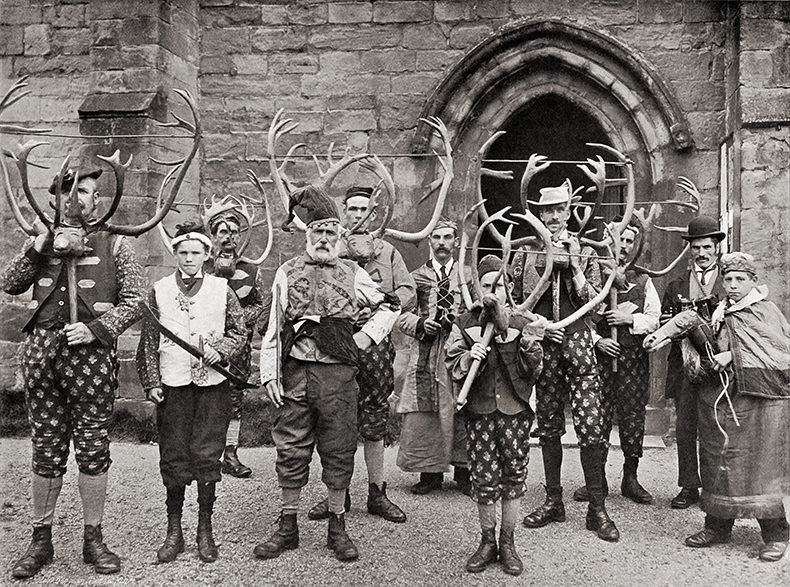
Players in the Abbots Bromley Horn Dance, photographed by John Benjamin Stone in c. 1900
The exhibition claims to be the first in the UK dedicated to British folk costume. Most of the artefacts belong to the Museum of British Folklore, which aims to ‘promote, celebrate and revitalize the folk heritage of Britain’ and, eventually, establish a physical home for its collection. The show traces the history of various costumes and the events to which they are tied. Many were suppressed under Cromwell’s government, subsequent reappearance after the return of Charles II, and resurgence – in a rather more respectable form – in Victorian times. When John Ruskin became involved with Whitelands College – a teacher-training college for women, then based in Chelsea – he proposed a revival of May Day celebrations, always a big part of the calendar after the Restoration. Then, they would usually involve drunken dancing around a Jack-in-the-Green figure; Ruskin’s version was more civilised, based on the election of ‘the likeablest and the loveablest’ of the students of Whitelands as May Queen. Their understated costumes, some of which can be seen here, have little in common with the gaudy colours and expressive shapes in the rest of the exhibition.

Portrait of Spencer Horne at the Jack-in-the-Green Festival, Hastings. Photo: Henry Bourne
‘Making Mischief’ suggests that something of an upswing in folk rituals is underway, with the final rooms showing more than 40 examples of costume from contemporary celebrations across Britain. Among the costumes are Morris-dancing outfits of all types, headgear from the Bridport Hat Festival and a dress from the Notting Hill Carnival. There are more hooded horses – most notably two Mari Lwyd horses from Monmouth. Used in celebrations of Hen Galan (the Old New Year) and Christmas, the Mari Lwyd are much more imposing than the hooden horse, their heads consisting of a horse’s skull with gold balls in the eye sockets. Even this feels friendly compared to the Dorset Ooser get-up, a monstrous bull-like mask with long red horns and a black cape (it has been used on the cover of multiple editions of the Reader’s Digest Folklore, Myths and Legends of Britain). The Ooser and Mari Lwyd horses make Ruskin and co.’s idealised view of folk tradition seem twee and dull in comparison.
Some of these costumes seem to have been unchanged for centuries, such as those from the annual Festival of the Horse in Orkney, where some children dress as highly decorated horses, while others take part in a ploughing contest on the sand of a nearby beach. Others are more up-to-date, such as the outfits worn by Boss Morris, a female Morris group from Gloucestershire whose bright costumes and face paints are influenced more by electronic dance music than traditional Morris dancing.
Alongside the costumes, the exhibition shows five films made by the folklorist, author and film-maker Doc Rowe. These show flaming tar-barrels being carried around Ottery St Mary in Devon and the Obby Oss festival in Padstow, which regularly draws more than 30,000 people to a town of 3,000 inhabitants. In a film about the Chinese New Year celebrations in London’s Chinatown, a dragon – another culture’s version of the hooded animal – dances around eating lettuces from the doorways of local businesses.
In their variety, the costumes in ‘Making Mischief’ convey distinctly local identities and a sense of pride in those identities – which can, however, be redefined to fit current requirements, as the costumes of Boss Morris show. And as in the case of Old Crockern, reference to an ancient myth can strengthen the claim of a community that feels its rights are being taken away. The week after the protest, Dartmoor National Park Authority launched an appeal against the ruling in Alexander Darwall’s case.
‘Making Mischief: Folk Costume in Britain’ is at the Compton Verney, Warwickshire, until 11 June.
From the April 2023 issue of Apollo. Preview and subscribe here.
Unlimited access from just $16 every 3 months
Subscribe to get unlimited and exclusive access to the top art stories, interviews and exhibition reviews.

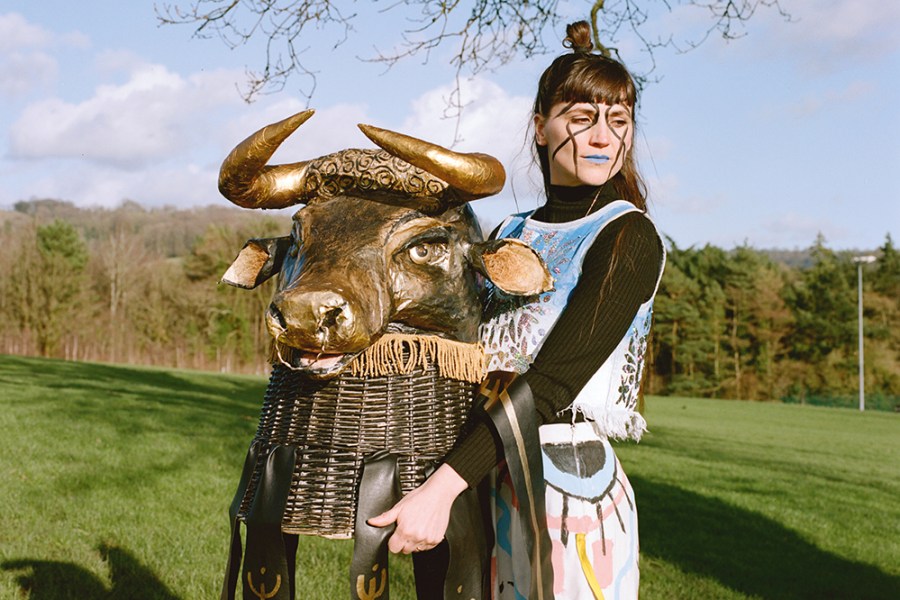
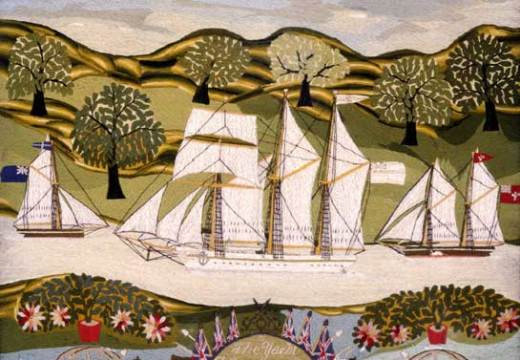
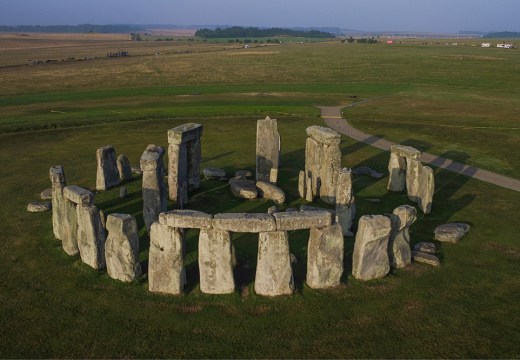
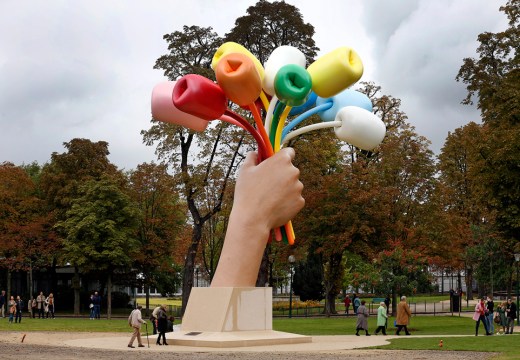









![Masterpiece [Re]discovery 2022. Photo: Ben Fisher Photography, courtesy of Masterpiece London](http://www.apollo-magazine.com/wp-content/uploads/2022/07/MPL2022_4263.jpg)
It’s time for the government of London to return to its rightful home